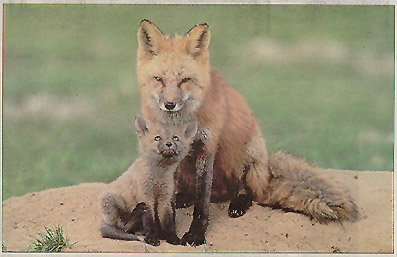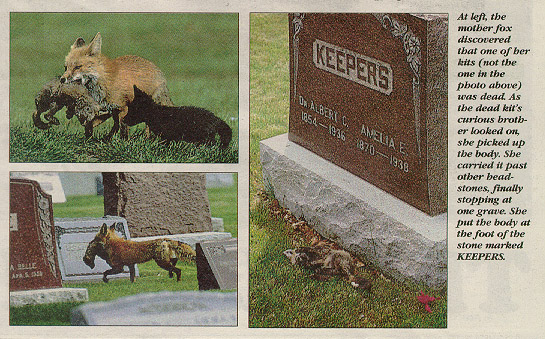
Wild
in the City
By Claire Martin
(from the Denver Post Empire Magazine, December 28, 1997)

What Wendy Shattil saw in the
cemetery one spring day was a reversal of the ancient line from
"The Book of Common Prayer": In the midst of death, she
found life.
Shattil was visiting her grandmother's grave, cleaning away
debris. As she tidied the grave site, she thought she saw
something prance about 100 yards away. She looked again, and saw
a red fox playing with a couple of young kits.
She smiled and wondered what her late grandmother would have
thought of the sight. Perhaps she would have said that it
perfectly captured the last years of their relationship.
Before she died, at age 100, Matilda Solomon often complained
that her granddaughter's wildlife photography business meant that
Shattil spent more time with wild animals than she did visiting
Solomon. But she also loved the stories Shattil told about her
adventures in the field.
And now, here was another adventure, right beside her
grandmother's final resting place. Shattil was back, with her
cameras, the next day.
And the next day. And the next. For nearly four years, she went
to the cemetery. Somewhere, she thought, her grandmother was
smiling, appreciating the irony: Finally, Wendy found a way to
combine visits with wildlife photography.
"I visited my grandmother's grave, and the foxes,
religiously for months," Shattil said. (She withholds the
cemetery's name, worried that the foxes might be harassed.)
It was one of the few times she's done a solo photo project, and
the first book she's done on her own. Usually, she and her
partner, wildlife photographer Bob Rozinski, work so closely as a
team that they share the credit line on the photographs they sell
to nature and conservation magazines - National Wildlife,
Audubon, National Geographic, Ranger Rick, Natural History - and
Sierra Club calendars.
And they initially shared the credit line on the photo that won
the prestigious international BBC Wildlife competition in 1990.
Then the BBC called the Shattil/Rozinski office.
"Bob answered the phone, and they said, 'We must know which
of you took this picture,' and he said, 'Oh, well, it's Wendy's,'
and then we found out it was the grand-prize winner, which they
were not about to give to two people," Shattil said.
The grand-prize winner, as it happens, was a picture of an
intent, clear-eyed fox - not one of the foxes from the cemetery -
surrounded by grass and wild-flowers.
"It's odd, what foxes do to us," Shattil said.
When she first began photographing the cemetery foxes four years
ago, Shattil figured she'd use the results in a magazine, as a
photo-essay about her grandmother. The fox project seemed somehow
personal, a kind of tacit pact that had as much to do with
Shattil's grandmother as it did with the foxes. She never thought
her photographs and journal would become a book.
"If I had," Shattil said, "Bob and I would have
done the project together."
Instead, "City Foxes" (Denver Museum of Natural
History/Alaska Northwest Books) became Shattil's second solo
book. Susan J. Tweit's text is drawn from the journals Shattil
kept as she was photographing the foxes.
During the years she photographed the cemetery foxes, Shattil
drove her truck to the cemetery every morning and afternoon for
several months a year. She sat in the truck for two or three
hours at a time, lens balanced on the open window. She got to
know the groundskeepers and the regulars who came through the
cemetery. Besides the people who came to visit graves or drop off
flowers, there were picnickers and joggers, dog-walkers and
strollers. One groundskeeper deliberately walked by the fox den
on his daily rounds to make sure the family was OK and that the
dog-walkers weren't letting their pets run amok. Sometimes
drivers in funeral processions noticed Shattil keeping vigil and
paused to see what was so interesting. If they saw the foxes,
often they'd stop to watch, too.
The best fox-watching days began when the kits first began
venturing out of the den, when they were about 6 weeks old.
Before that, Shattil would see the male fox trotting in and out
of the den. When the female, looking haggard, finally emerged,
Shattil knew that before long, the babies would follow. At first,
the kits cautiously poked only their heads above ground. Fluffy
with gray-black baby fur, they peered around curiously and a
little myopically. Dazzled by the bright daylight and unnerved by
the vast world, they stayed close to their mother.
Later, as the kits grew braver, they played games that looked a
lot like chase and hide-and-seek. They pretended to fight,
attacking one another's faces and necks with their sharp little
teeth. They pounced on prey, real and imagined, hunting bugs and
snapping at the carcasses of small birds and animals that their
parents brought home.
Shattil spent four years photographing a series of fox families
at the cemetery. She was surprised, the first year, when the
parent foxes split up, just six weeks after the family's six kits
were born. Foxes usually pair up until the kits are grown. Often,
the same pair return year after year to an established den. But
this time, the male fox left with five of the kits and moved to a
different den. The sixth kit stayed with the mother in a den next
to a gravestone.
"What happened? We don't know," Shattil said.
"That sixth kit was small. Maybe it wasn't weaned yet, and
the father took the weaned kits off to another den. I only know
that the second year, a different pair of foxes were back. This
group of foxes, they mixed and matched, a lot. That, or it was a
large extended family. It's not unusual for a female to stay on
another year and help care for her mother's next litter. The
third year, same place, a different team of foxes came back, with
another adult, perhaps a grown kit from the previous year."
She Faithfully recorded their lives, charmed and interested as
she watched the kits grow up. She forced herself to go to the
cemetery, even on days when other projects seemed more
interesting.
"I've learned," she said, "that if you don't go
out, you don't know what you miss.
"One day last spring, I didn't feel like going out at all,
but I made myself go. I was watching the mom trot toward the den,
and four black kits exploded out of the den. But I knew there
were five kits in the litter. The mom looked up for the fifth
one. Looked and looked. But the fifth one didn't come out."
 The mother went into the den. She
emerged with the fifth kit in her mouth. It hung lifelessly from
her lips. The mother carried the dead kit away from the den. When
one of the kits followed her, she stopped, put down the body, and
waited patiently until the other kit grew bored and rejoined its
brothers and sisters at the den. Then she picked up the dead kit
and trotted on.
The mother went into the den. She
emerged with the fifth kit in her mouth. It hung lifelessly from
her lips. The mother carried the dead kit away from the den. When
one of the kits followed her, she stopped, put down the body, and
waited patiently until the other kit grew bored and rejoined its
brothers and sisters at the den. Then she picked up the dead kit
and trotted on.
Shattil followed, driving her truck slowly along the cemetery
road. She saw the mother pause, and she braked. The mother fox
laid the dead kit at the foot of a gravestone. She paused. Then
she trotted back to the den.
Shattil got out of her truck. She walked over to the gravestone
where the little fox kit lay. The name on the gravestone was
"Keepers."
When she returned the next day, the kit's body was gone.
"It was the saddest thing," she said later. "To
see a behavior like that. Much less photograph it. At this point,
those foxes are part of my family. Their den is just down the
road from my grandmother's. My heart went out to that
mother."
The photographs from that day aren't in "City Foxes."
The book was already at the printer. Besides, Shattil wasn't sure
that such a vivid sequence about death was appropriate for a
children's book.
But she wishes that one other photo from the fox project had been
taken before the printer's deadline. She spent days hoping to
photograph a fox alongside a certain tombstone near the place
where the foxes hunt magpies. Always, the fox was just outside
the parameters of the shot Shattil wanted.
Then, finally, it happened: The mother trotted right in front of
the gravestone, just as Shattil clicked the shutter, and she got
her photo.
It is a perfect portrait of a fox looking right into the lens,
with a panting smirk, as it passes the gravestone labeled FOX.

Claire Martin is the staff
writer for Empire Magazine.